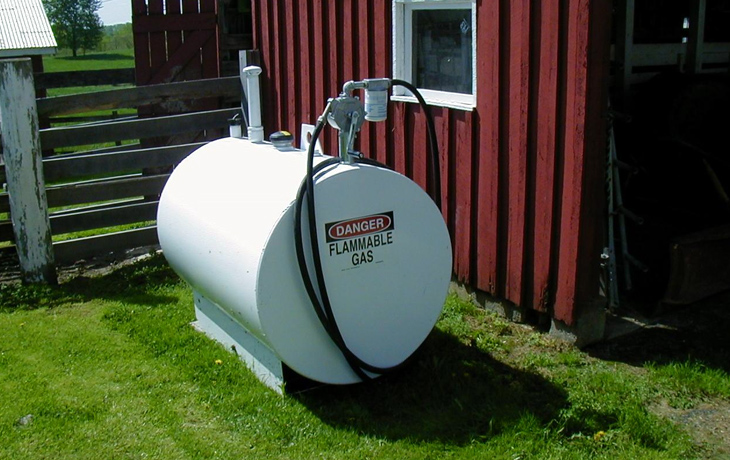A sudden evacuation, power loss, or SHTF event is not the time to wait in line with other panicked people at a gas station — if it’s even open and supplied to begin with! You may need to bug out quickly or immediately run a generator for medical reasons, for example.
Review: Best gas can
Summary:
- At minimum, preparedness experts recommend that you always have enough gas around to fill your main vehicle from empty to full (roughly 15-20 gallons).
- It’s easy — the vast majority of people keep a few affordable five gallon jerry cans in their garage with annual rotation. That’s it!
- There’s a meaningful difference in quality and safety between a “proper” metallic can and the more commonly seen plastic ones.
- Official guidelines say to use a metal container, but most people do fine with plastic as long as they aren’t dumb about safety.
- More robust options include 10-50 gallon semi-portable tanks, 10-150 gallon accessory tanks mounted to your vehicle (eg. in a truck bed), or large >200 gallon above-ground tanks permanently installed on your property.
- Standard gasoline has a relatively short shelf-life. It starts degrading in a month, and most people avoid using gas once it’s 6-12 months old.
- But if you add a fuel stabilizer, you can multiply the lifespan and keep gas stored for a few years.
- Diesel fuel generally lasts much longer, to the point most people don’t feel the need to add stabilizers if the fuel will be used within a few years.
- Normal gas doesn’t really freeze until -50 degrees F (-45 C) or worse — but it can start to thicken and cause engine problems below -10 F (-23 C). Stabilizer will help.
- Diesel freezes (called “gelling”) sooner than normal gas, causing problems below 10-15 degrees F (approx -10 C). Stabilizer helps here, too.
- Use your head with storage: only use proper containers, stay away from heat / spark / flame sources, don’t store inside your home (garages are usually okay), avoid direct sunlight, be mindful of fumes, etc.
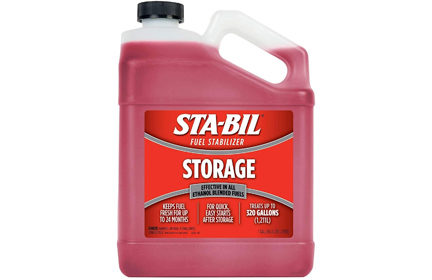
Sta-bil Fuel Stabilizer
Check local laws
Lame disclaimer time! Gas is dangerous. Which means it’s regulated by the government and any discussion around it often includes tons of overly-cautious warnings.
Generally speaking, you don’t need permission to store gas on your property. But there are various state, county, and city ordinances that may apply. HOAs and multi-unit buildings may also have their own rules, too.
Tip: A good resource is your local fire department. We’ve installed large systems in the past, and the local FD was great about giving tips on location, laws, and so on.
For example, one time when installing 1,000 gallons of above-ground tanks in an area prone to wildfires, the fire department told us the minimum distance they needed between the house and fuel tanks (essentially large bombs) to still feel safe while trying to save the home from fire.
Types of gas storage
Generally speaking, people tend to start at the top and work their way down:
- Small jerry cans you carry with one hand
- Accessories specifically made for your vehicle, mostly found in trucks, off-roaders, etc.
- Semi-portable options that are the size of a few jerry cans
- A large tank installed on your property, likely above ground.
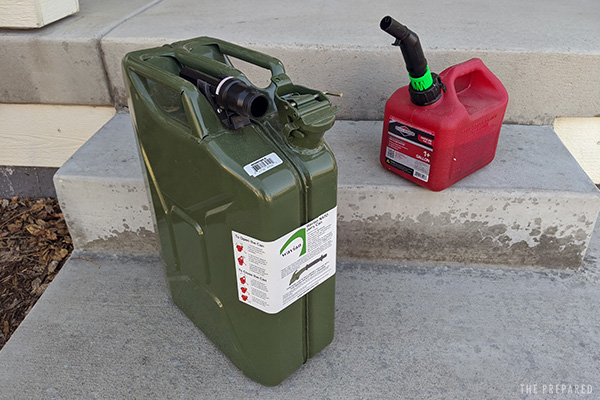
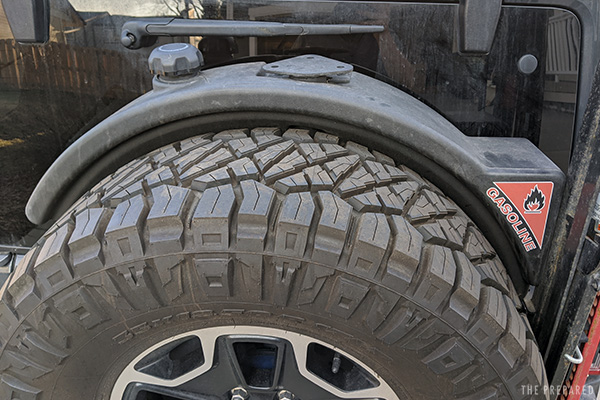
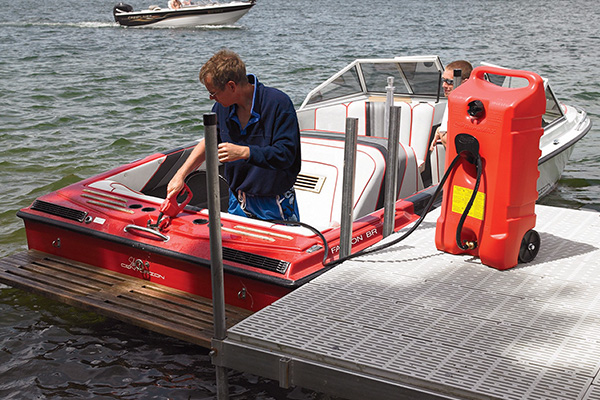
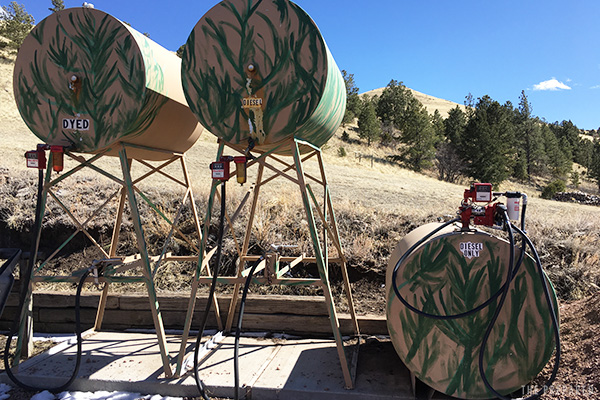
How long does gas last?
Gas is a mix of multiple components. Those individual components can split apart, degrade, or evaporate over time.
Standard gasoline starts to go bad after 30 days. It’s not a black-and-white change, though. Similar to medicine after its expiration date, gas doesn’t suddenly become toxic or unusable — the efficiency goes down over time, eventually reaching the point it does more harm than good inside of an engine.
When exposed to oxygen and water, for example, gas begins to oxidise the same way that iron rusts. You wouldn’t let your firearm rust, so treat your gas stores with the same care!
What happens if I use stale gas? Or gas-oil mixes?
You might end up in a scenario where you need gas but don’t have fresh stuff on hand.
The older the gas, the more likely the engine will sputter or not start at all. If you can get the engine going and it seems to idle okay for a little bit, it’s likely going to work fine with a few burps and hiccups along the way — and possible long-term damage you’d fix after the emergency.
Since gas doesn’t suddenly go from functional to broken, it’s often more of a judgement call than a simple answer: how much you need gas vs. how old it is vs. how much you’re willing to damage your engine.
Another scenario: You need gas for your vehicle to evacuate, but all you have on hand is a gas and oil mixture used by two-stroke tools like weed eaters and small lawn mowers.
That’s probably fine, too. The car (or other four-stroke engine that normally keeps gas and oil separate) might sputter, smoke, or otherwise be grumpy — but it’ll do in a pinch, especially if there’s any pure gas left in the tank to help dilute the oil-gas mix you pour in.
Fuel stabilizers like Sta-bil are an easy way to keep gas from going bad
And it doesn’t cost much, either — an $8 bottle of Sta-bil treats 40 gallons for a year. These products are commonly found at auto stores, gas stations, and Walmart.
All you have to do is pour the stabilizing agent into your tank. They work by neutralizing the chemical reaction that causes gas to break down over time.
Most products only need to be used once for a year’s worth of shelf life. At the end of the year, you can either use the stored gas and refill it with new fuel (our recommendation), or redo the stabilizer treatment for a year extension.
The use and replace method
One of the basic models in prepping is the First In First Out “store what you use, use what you store” concept.
It can work well for gas storage, particularly if you don’t want the expense or hassle of using stabilizer, or if you want to have lots of gas on hand but can’t use larger tanks.
Most people have one tank: the one in their car. They wait until it gets low, fill it up, use it, repeat.
Instead, you could keep a few full cans in your garage and top off your vehicle with the oldest gas you have around. Then, as you use the gas from the cans, you take those to the gas station and refill them.
That doesn’t require much of a habit change, so it’s easy to do. And you won’t need to fiddle with stabilizers as long as the gas in the garage is never more than six months old. Once you get the rhythm of how much you use in daily life, you can find the right balance and essentially always have six months worth of gas on hand without it ever going bad.
If you want to get really advanced without the big tanks, you can extend this same cycle concept with the addition of stabilizer. So when you fill your car in daily life, you’re actually using gas from one or more years ago.
Safety matters
A lot of the safety warnings around gasoline are so broad or extreme that most people ignore them. But there are real dangers.
The vapor from just one cup of gasoline has the explosive energy of five pounds of dynamite. That’s why we use gasoline to begin with: high energy density makes it an ideal portable fuel. That’s why a gallon of it can push a two-ton vehicle over ~25 miles.
Treat gasoline around your home with the same respect you would a firearm.
That means keeping it in a thoughtful location, away from children, away from things that can accidentally make it go boom, etc.
More: Best fire extinguisher for your home and vehicle
Where to store gas
- The ideal place is somewhere protected from the elements yet separate from your home. Detached, enclosed garages and barns are perfect.
- No matter what, don’t keep gas inside your home. The vapors are too dangerous.
- An attached garage is typically okay if the rest of the criteria is met.
- Stay far away from heaters, fireplaces, sources of sparks, sunny windows, etc.
Since gas fumes are heavier than air, they can travel substantial distances along the ground, kind of like a morning fog. Those vapors can be ignited by heat alone — they don’t need a distinct spark or flame. Keep that in mind when picking a spot.
How to safely transport gasoline (and is it legal to drive with gas?)
Yes, it’s generally legal in these personal situations. Local laws will often set a maximum gallon limit so there’s a line between personal and commercial use.
Only keep gas stored in/on your vehicle for the long term if the container was specifically built for that (eg. the bolted-in truck bed tanks).
You can certainly put any proper container in your trunk when going back and forth to the petrol station, but that’s it — don’t keep the full plastic jug in your trunk “just in case.”
Cars get hot. Heat causes vapors. Vapors cause boom. Or cars get crashed. More boom.
Fill your cans on the ground to avoid static electricity
A common mistake is filling up gas containers without putting them on the ground first. When a container is sitting on surfaces like a carpeted trunk or truck bed, static electricity can cause a spark in the vapors.
This woman simply gets out of her car and touches the pump nozzle. Yet the static electricity from rubbing against the seat fabric was enough to set this off:
If you have an accident
Spills:
- For small spills, soak up the gas with rags, sawdust, kitty litter, paper, anything.
- For larger spills, try to contain it around the edges from spreading any further (eg. wrap a garden hose in a circle around the spill), then collect the liquid.
- Don’t put it down rainwater drains, ever.
- Try not to put it in your standard garbage — many areas have hazardous waste drop offs or other laws concerning disposal.
Gets in your eyes:
- Do whichever of these is fastest: get in the shower or use a sink to flow fresh water over yours eyes
- Hold your eyelids open and let water run through for 15 minutes
- Take your contacts out and leave them out until you feel fine again
- Don’t use eye drops unless told to by a professional
- Call 911 or an eye doctor (ophthalmologist)
